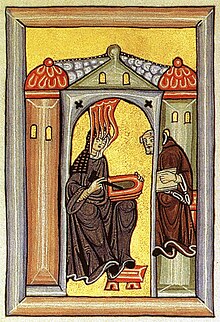
Back Hildegard van Bingen Afrikaans Hildegard von Bingen ALS هايدغارد بنجين Arabic هايدجارد بنجين ARZ Hildegarda de Bingen AST Binqenli Hildeqard Azerbaijani هیلدقارد بینقنی AZB Hildegard vo Bingen BAR Хільдэгарда Бінгенская Byelorussian Гільдэгарда Бінгенская BE-X-OLD
Hildegard of Bingen | |
|---|---|
 | |
| Virgin, Doctor of the Church | |
| Born | Hildegard von Bingen c. 1098 Bermersheim vor der Höhe, County Palatine of the Rhine, Holy Roman Empire |
| Died | 17 September 1179 (aged 81) Bingen am Rhein, County Palatine of the Rhine, Holy Roman Empire |
| Venerated in | Roman Catholic Church, Anglican Communion, Lutheranism |
| Beatified | 26 August 1326 (Formal confirmation of Cultus) by Pope John XXII |
| Canonized | 10 May 2012 (equivalent canonization), Vatican City by Pope Benedict XVI |
| Major shrine | Eibingen Abbey, Germany |
| Feast | 17 September |
Philosophy career | |
| Notable work | |
| Era | Medieval philosophy |
| Region | Western philosophy |
| School | Neoplatonism |
Main interests | mystical theology, medicine, botany, natural history, music, literature |
Notable ideas | Microcosm–macrocosm analogy, Eternal predestination of Christ, viriditas, Lingua ignota, humoral theory, morality play |
|
Preview warning: Page using Template:Infobox philosopher with unknown parameter "influences" Preview warning: Page using Template:Infobox philosopher with unknown parameter "influenced" | |
| Part of a series on |
| Christian mysticism |
|---|
 |
| Part of a series on |
| Medieval music |
|---|
| Overview |
|
|
Hildegard of Bingen (German: Hildegard von Bingen, pronounced [ˈhɪldəɡaʁt fɔn ˈbɪŋən]; Latin: Hildegardis Bingensis; c. 1098 – 17 September 1179), also known as Saint Hildegard and the Sibyl of the Rhine, was a German Benedictine abbess and polymath active as a writer, composer, philosopher, mystic, visionary, and as a medical writer and practitioner during the High Middle Ages.[1][2] She is one of the best-known composers of sacred monophony, as well as the most recorded in modern history.[3] She has been considered by a number of scholars to be the founder of scientific natural history in Germany.[4]
Hildegard's convent at Disibodenberg elected her as magistra (mother superior) in 1136. She founded the monasteries of Rupertsberg in 1150 and Eibingen in 1165. Hildegard wrote theological, botanical, and medicinal works,[5] as well as letters, hymns, and antiphons for the liturgy.[2] She wrote poems, and supervised miniature illuminations in the Rupertsberg manuscript of her first work, Scivias.[6] There are more surviving chants by Hildegard than by any other composer from the entire Middle Ages, and she is one of the few known composers to have written both the music and the words.[7] One of her works, the Ordo Virtutum, is an early example of liturgical drama and arguably the oldest surviving morality play.[a] She is noted for the invention of a constructed language known as Lingua Ignota.
Although the history of her formal canonization is complicated, regional calendars of the Roman Catholic Church have listed her as a saint for centuries. On 10 May 2012, Pope Benedict XVI extended the liturgical cult of Hildegard to the entire Catholic Church in a process known as "equivalent canonization". On 7 October 2012, he named her a Doctor of the Church, in recognition of "her holiness of life and the originality of her teaching."[8]
- ^ Bennett, Judith M. and Hollister, Warren C. Medieval Europe: A Short History (New York: McGraw-Hill, 2001), p. 317.
- ^ a b Worl, Gayle (9 March 1997). "WOMEN OF HISTORIC NOTE". The Washington Post. ISSN 0190-8286. Retrieved 22 November 2023.
- ^ Jones, Gaynor G.; Palisca, Claude V. (2001). Grout, Donald J(ay). Oxford Music Online. Oxford University Press. doi:10.1093/gmo/9781561592630.article.11845.
- ^ Jöckle, Clemens (2003). Encyclopedia of Saints. Konecky & Konecky. p. 204.
- ^ Campbell, Olivia, Abortion Remedies from a Medieval Catholic Nun(!), JSTOR Daily, October 13, 2021
- ^ Caviness, Madeline. "Artist: 'To See, Hear, and Know All at Once'", in Voice of the Living Light: Hildegard of Bingen and Her World, ed. Barbara Newman (Berkeley: University of California Press, 1998), pp. 110–24; Nathaniel M. Campbell, Imago expandit splendorem suum: Hildegard of Bingen's Visio-Theological Designs in the Rupertsberg Scivias Manuscript in Eikón/Imago 4 (2013, Vol. 2, No. 2), pp. 1–68, accessible online here Archived 16 July 2014 at the Wayback Machine.
- ^ Burkholder, J. Peter, Claude V. Palisca, and Donald Jay Grout. 2006. Norton anthology of western music. New York: W.W. Norton.
- ^ Pope Benedict XVI, Apostolic Letter Proclaiming Saint Hildegard of Bingen, professed nun of the Order of Saint Benedict, a Doctor of the Universal Church, 7 October 2012.
Cite error: There are <ref group=lower-alpha> tags or {{efn}} templates on this page, but the references will not show without a {{reflist|group=lower-alpha}} template or {{notelist}} template (see the help page).
© MMXXIII Rich X Search. We shall prevail. All rights reserved. Rich X Search